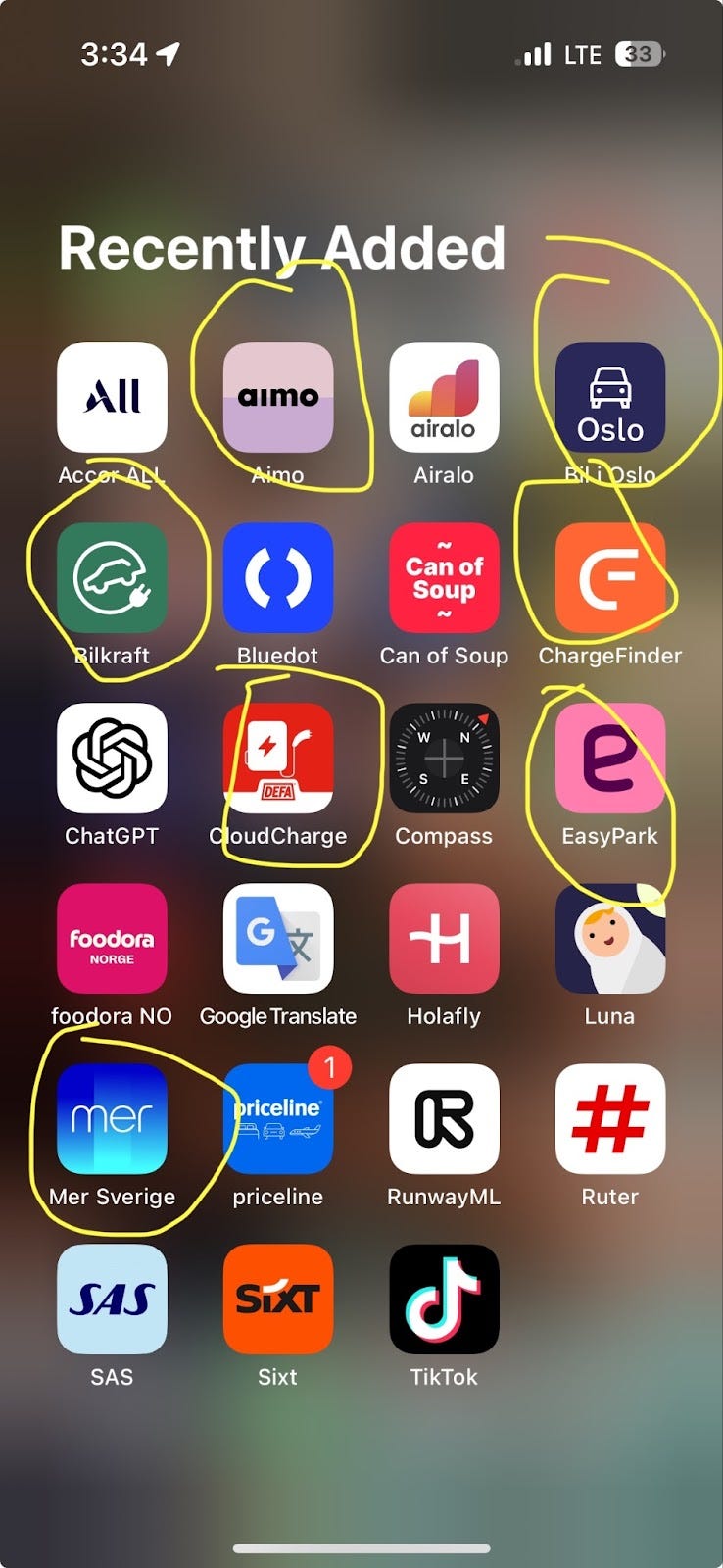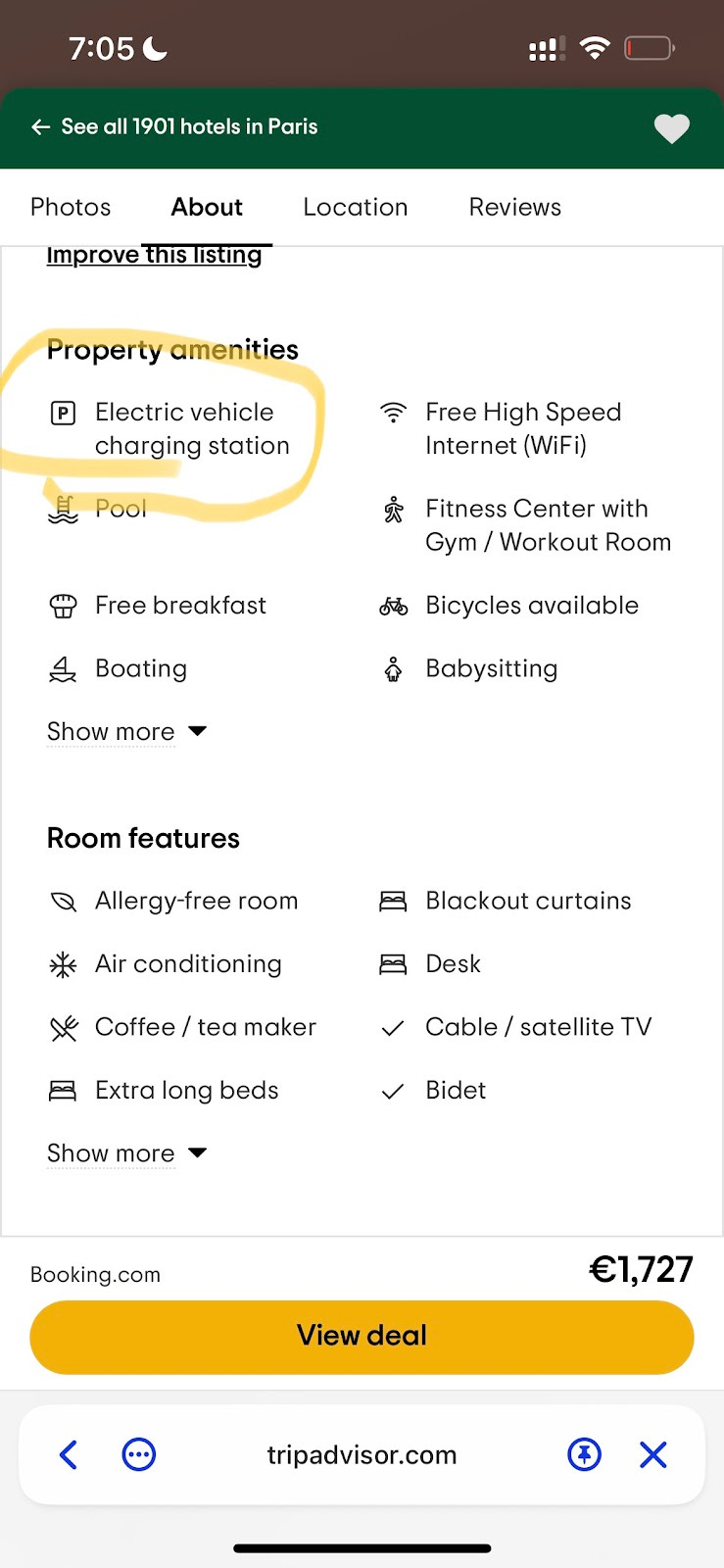August 2023: The Electric Vehicle charging orchestration layer
A "Plaid" style solution is needed for EV charging
I recently spent a couple weeks road tripping in Sweden & Norway and decided on an EV as my choice of transport. Lately when I travel, I try to rent an EV just to see what it’s like (I don't own one personally). I like the drive, but overall my observation was that I had to download multiple apps to a) park and b) charge my EV. The parking problem is universal to all cars. The charge problem is specific to EVs. Both present an opportunity - the 7 apps I had to download in a 2 week period[1] don’t even account for the charging stations I simply couldn’t use because the apps/websites were down, buggy or I just couldn’t figure out (in one example I couldn’t even get my phone number authenticated). Lastly, I’ve no idea why, but I could not pay at any charge point using a credit/debit card (there was literally no payment terminal).
Opportunities
This fragmentation is without question a garbage consumer experience (I know because I lived it). Multiple times over a two week period I pulled up at a charging station and simply couldn’t figure it out. I can think of a few ways you’d solve this.
EV aggregator for drivers
This is similar to Bluedot in the US, whose founders I met recently. The experience is for one app to rule them all, that aggregates EV charging networks for consumers, fleets, and employers, and orchestrates payment, money movement, and charging initiation. I love the idea, and I’m mostly not sure how similar the US & EU electric vehicle problem spaces are, so this might work very well. One material challenge with this is getting distribution; consumer distribution in any space is expensive, and now you have to be both good at all the EV charging infrastructure and assembling the ecosystem, AND good at acquiring consumers sustainably
EV charging orchestration
This would be an API that solves 3 problems in parallel:
Parking: Loading parking spots and enabling a consumer to park
Charging: loading charging spots, making it easy to find a compatible charger, and remotely initiate and track the charging process
Pricing: surfacing the cost & time to charge so that consumers can easily price compare
Payments: handle authentication, payments and settlement directly between the consumer and the charging networks
Promotions: developing the driver acquisition infrastructure for charging networks to try and steer or acquire drivers from these apps
The way you’d deploy this is as an API that several different types of companies might embed, including:
Financial services & fintechs: this is interesting to them because they benefit from actually orchestrating the payments and money movement, they can directly monetize off of it, and it drives continued engagement.
Trucking Cos & Fleets: As large portions of these fleets convert to electric, the telematics services and apps they use for mileage & other activities are a natural place to handle payments, steer driver behavior to preferred networks, and initiate charging
Car rental companies: feels natural for this to be inside Hertz or Sixt. In fact as a renter, very often in a different country which is likely to have different charging infrastructure, feels silly to expect consumers to figure this out (would be different if payments just happened at terminals, but they don’t)
Car Manufacturers: with this you could turn the car directly into a payment instrument; ie each car already has a payment credential attached to it, and plugging the car into the port *is* the authentication (Tesla already does this with its cars and charging network; an orchestration platform would make this possible for any car manufacturer)
Travel: hotels and airlines often have charging stations on site, and airline apps already attempt to cross-sell car rentals in them. Both often already have payment credentials embedded, so these are natural places to discover what’s nearby, and initiate and track a charge. Travel apps like TripAdvisor already show charging stations as a property amenity. It’s not crazy for them to step into the charging transaction.
Maps: maps already facilitate charging network discovery (for instance, when driving, Apple Maps showed what my charge would be when I reached my destination. Again, not crazy that they’d also facilitate charge initiation if an SDK made it easy enough). They’re not as good at this as dedicated charge point apps, but I assume they will improve over time. A very natural next step is for maps to help initiate charging and orchestrate payments along the way.
One reason this opportunity exists is because the software infrastructure required to enable it is the same across all these categories and it would be a massive dead-weight loss for all these entities to build this themselves. For all these entities, embedding would also provide incremental monetization opportunities via affiliate arrangements or promoted charging networks.
Benefits & Incentives
When building ecosystem aggregation businesses like these (where you have to get a bunch of disparate entities to agree to work together), you have to understand everyone’s incentives in a very nuanced way, as individual entities choosing not to participate in the network meaningfully degrade its value and can ultimately destroy you. Plaid’s early struggles with the banking sector are a good example of this (although it seems like they’re mostly over this hump). I think in this ecosystem, you’re dealing with drivers, charging networks, and distribution entities who will ultimately be your customer.
Charging networks want this because it costs them money; before returning my EV, I attempted to charge it over the 70% threshold at no less than 6 charging stations, and was unsuccessful each time; either the charging station was down, the app wouldn’t work, sms wouldn’t work, instructions were unclear, or something else. That’s a revenue opportunity they all missed, mostly due to fragmentation.
Distribution entities want this because (apparently) the transition to EVs is coming with a transition in overall consumer behavior, including payment modes, which is an opportunity to make their consumer touchpoints more sticky and useful, and an additional opportunity to monetize (either on payments or promotions). One notable thing was that I couldn’t just tap a credit card at any charging station. No idea why this is (feels like it has to be regulatory), but it’s a crazy missed opportunity - in every single case I had to download an app and go through some tortured authentication process in order to use the charge point.
Consumers want this because the fragmented experience is subpar; it wastes time and causes cognitive load and frustration.
Challenges & Caveats
A few caveats or challenges have hit me as I think this through. First and most significant is that I neither live in Europe nor am I an EV owner. It's entirely possible this problem is localized to Scandinavia because of how mature it is, and that’s not obvious to me. Second, there might be regulatory reasons for this market structure that no aggregation play is going to get around. Third, the actual right answer might be non-mobile - just rolling out payment infrastructure that is directly at the terminal so drivers don’t have to download an app. Fourth, I don’t have the strongest idea of how to model the market dynamics of people being able to charge at home (vs. ICE cars where you always get your fuel at a station). It might be the case that this problem only truly applies to renters, because if you live somewhere, you have a “home” charger, which is either your literal home, or the charger closest to you where you know you can reliably park and charge (or even a charger at your office, assuming you commute). This becomes far less interesting if it’s a product that’s only for car rentals.
[1] This tourist guide outlines how many there are for Norway alone, with no interoperability: https://elbil.no/ev-tourist-guide-to-norway/#:~:text=Fast%20charging,app%20to%20activate%20the%20chargers
Thanks to Aaron Frank, Aman Manik, Justin Overdorff, Ferhat Babacan, Selina Filiz Parlak, and Kat O’Brien for reading this in draft form.




" First and most significant is that I neither live in Europe nor am I an EV owner. It's entirely possible this problem is localized to Scandinavia because of how mature it is, and that’s not obvious to me. "
Absolutely not. I live in N. California & have a non -Tesla EV and the same thing is true. I have about 5 different apps on the phone and there are other chargers around. Impossible to tell if they are used or empty or working or not in most cases, and yes, you cannot just show up with a credit card and tap. It should be like the London Transport network which now allows you to tap a credit card on or off any tube, bus or train AND it figures out your best fare over the day or week (i.e. if you'd been better off buying a weekly ticket, it gives you that price). Why the different charging companies can't let you tap a credit card when any tiny store anywhere in the world does is beyond me...
Talk to the team at Smartcar (https://smartcar.com/)!